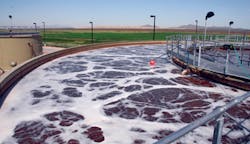Reclaimed Water System, Alternative Energy Helps Snack Food Manufacturer Win U.S. Water Prize
The Clean Water America Alliance (CWAA) has awarded PepsiCo Frito-Lay a 2012 U.S. Water Prize for its Casa Grande, Ariz., snack food manufacturing facility. Thanks to an innovative process water reuse system and alternative energy, the facility runs almost entirely on renewable energy and recycled water while producing nearly zero waste - something the company refers to as "Near Net Zero."
CDM Smith completed the design and construction of the 650,000-gallon-per-day process water recovery treatment system, which recycles up to 75 percent of the facility's process water. As a result, Frito-Lay has been able to reduce its annual water use by up to 100 million gallons.
The advanced purification system incorporates screening, sedimentation, membrane bioreactor (MBR), activated carbon, ultraviolet, low pressure reverse osmosis, water stabilization and chlorine disinfection to treat the effluent to U.S. Environmental Protection Agency (EPA) primary and secondary drinking water quality standards, allowing it to be reused to wash and move potatoes and corn. This is the first U.S. food processing plant that produces drinking water quality process water to be reused in food production.
Several processes at the facility are large consumers of water. Potatoes are moved and washed in a flume as they are prepared for processing. During peeling and slicing, starch is flushed away, but is later reclaimed for resale. For corn, water is used in a caustic soak that loosens the hulls, also in a starch reduction step and in cooking.
The starch water is sent into a segregated water line so the starch can be removed and processed. The water and starch are separated in a vortex, high speed separation process. The concentrated starch is dewatered on a vacuum filter, and then it is dried with a hot air dryer, bagged and sold for use as commercial starch product.
Equipment cleaning and sanitation also consume water. Equipment must be cleaned before any flavor change, and a more extensive cleaning is done every weekend.
All process water goes into the recycle stream and on to the Process Water Recovery Treatment Plant (PWRTP). The sanitary water from restrooms and the cafeteria kitchen is diverted to the city sewer.
At the PWRTP, a pump station lifts the process water up to internal fed rotary screens that capture corn kernels and pieces of potatoes and any large material. Water flows out of screens to an equalization tank, where staff adjust pH. From there it goes to primary clarifiers. Fine particles of corn and potatoes that settle in the primary clarifiers are removed by a bottom scraper. The settled material is blended with the larger screenings and then dewatered with Andritz centrifuges. The dewatered solids are used for animal feed.
After the primary clarifiers, the water flows to into bioreactor tanks, where an activated sludge step provides biological nutrient (nitrogen) removal, followed by ultrafiltration with GE Zenon membranes. A pressurized granular activated carbon system helps remove color and reduces BOD and COD.
The water is disinfected in a ENAQUA ultraviolet light (UV) system prior to flowing into a Low Pressure Reverse Osmosis (LPRO) system. The LPRO features use of Dow membranes but was assembled by ENAQUA. There are three membrane arrays, with two being used for average flows seen at the plant.
Influent BOD is around 3500 mg/l and non-detect in the recycled water . TSS is about 4,000 mg/l coming in and non-detect in the recycled water.
"The PWRTP is putting out drinking water quality water," said Al Goodman, P.E., Principal at CDM Smith. "In fact, it's better than their local drinking water."
After treatment through the LPRO system, operators add sodium bisulfite to stabilize the water and sodium hypochlorite to provide a chlorine residual. It then flows to a 210,000 gallon reclaimed water tank.
The LPRO recovers 75 percent of the water, while the 25 percent reject water goes to the city sewer. City makeup water is piped into the reclaimed water tank and blended with the recycled water. Water from the reclaimed tank is eventually pumped back to the head of the plant to meet production requirements.
The Process Water Recovery Treatment Plant started up in May 2010 and has performed as expected, meeting all water quality testing requirements.
"This has been a flagship project for CDM Smith and for Frito-Lay and PepsiCo," Goodman said. It has helped demonstrate "that you can take a food plant essentially off the grid and have near net zero environmental footprint."
The Casa Grande facility was the first snack food manufacturing facility in the United States to be awarded LEED® Existing Building Gold Certification from the U.S. Green Building Council, thanks to educational elements, enhanced process layout and energy-efficient motors.
With 80 percent of construction debris recycled for beneficial reuse, dewatered potato peelings and corn kernels sent to local farms for feedstock, and recovered potato starch sold for other manufacturing uses, the facility now sends less than 1 percent of its overall waste to landfill.
The facility has a 5-megawatt photovoltaic solar system that produces almost all of the plant's daytime electricity needs. CDM Smith completed the entire photovoltaic solar installation, including 36 acres of photovoltaic panels on dual-axis ground-mount systems, single-axis concentrated photovoltaic collectors, and dish collectors with Stirling© engine generators.
Goodman said the Casa Grande facility demonstrates that the technology exists to recycle water to the highest standards.
"We are quoting and proposing on other systems and other food and beverage companies that have observed this system," Goodman said. "We definitely see this as the path of the future."



